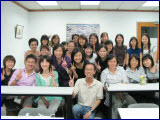- Home
- Basic Lessons
- Japanese Adjectives Part 2
Japanese Adjectives Part 2 -
Free Japanese Lessons: 6
This section will discuss how to connect 2 Japanese adjectives.
When there are 2 adjective sentences, how to join them together into one sentence?
The answer is to change the adjective in the first sentence to te-form (て-form), and connect it to the second adjective to form one sentence.
te-form has many functions and one of them is to connect sentences. You will get to see more of te-form in future lessons.
Now let's see how to change an adjective into its te-form.
How to Change to te-form for Japanese Adjectives?
To change to te-form for i-adjectives, remove the "い" (i) and replace it with "くて" (kute).
To change to te-form for na-adjectives, append "で" (de) at the end.
い-adj(~い) → い-adj(~くて)
な-adj → な-adj で
See the following examples...
- おいし
い→ おいしくて (oishikute): delicious - やす
い→ やすくて (yasukute): cheap
- きれい → きれいで (kireide): clean/beautiful
- しんせつ → しんせつで (shinsetsude): kind
Joining 2 Sentences with te-form
So joining these 2 sentences with te-form for i-adjectives,
- このりょうりはおいしいです。
kono ryouri wa oishii desu - このりょうりはやすいです。
kono ryouri wa yasui desu
it becomes...
- このりょうりはおいしくてやすいです。
kono ryouri wa oishikute yasui desu
Meaning: This dish is delicious and cheap.
And joining these 2 sentences with te-form for na-adjectives,
- たなかさんはきれいです。
tanaka san wa kirei desu - たなかさんはしんせつです。
tanaka san wa shinsetsu desu
it becomes...
- たなかさんはきれいでしんせつです。
tanaka san wa kirei de shinsetsu desu
Meaning: Ms Tanaka is beautiful and kind.
The important point is to change the first adjective, so you can even join one i-adjective to another na-adjective. Therefore the following 2 sentences are also valid.
- やまださんはおもしろくてげんきなひとです。
yamada san wa omoshirokute genki na hito desu
Meaning: Mr Yamada is an interesting and energetic person.
- やまださんはげんきでおもしろいひとです。
yamada san wa genki de omoshiroi hito desu
Meaning: Mr Yamada is an energetic and interesting person.
Rule to Note When Connecting 2 Adjectives
The 2 connected Japanese adjectives must not be of contradictory notion. That means when one adjective describes about "good" thing, the other adjective must not describe about "bad" thing.
Therefore you cannot describe a room as old and large using te-form, nor describe it as new and narrow. The following 2 sentences are NOT correct...
- このへやはふるくてひろいです。 X
kono heya wa furukute hiroi desu X
Meaning: This room is old and wide.
- このへやはあたらしくてせまいです。 X
kono heya wa atarashikute semai desu X
Meaning: This room is new and narrow.
You should describe the room as old and narrow, or new and large, like the following...
- このへやはふるくてせまいです。 O
kono heya wa furukute semai desu O
Meaning: This room is old and narrow.
- このへやはあたらしくてひろいです。 O
kono heya wa atarashikute hiroi desu O
Meaning: This room is new and wide.
In Summary, don't connect 2 contradictory Japanese adjectives using te-form. You will learn how to do that in future lessons.
Exception of te-form for いい
As you may have expected, the te-form for いい is よくて (yokute) but not いくて (ikute).
Best Deal of the Year! Get 68% OFF Lifetime Premium! Ends on 13 Dec 2025
Click Here to Get 68% OFF Lifetime Premium and be on the fast track to fluency in Japanese.
The link above is an affiliate link, which means that I would earn a commission (at no extra cost to you) if you do end up purchasing the related learning course.
Previous - Lesson 5: Adjectives
Next - Lesson 7: arimasu and imasu
Buy me a coffee









Facebook Comments
Don’t see the comments box? Log in to your Facebook account, give Facebook consent, then return to this page and refresh it.